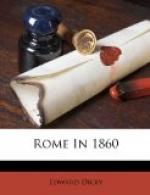The trial occupied but one day, and yet the above sentence, it appears, was not communicated to the prisoner till the 15th of October, 1858, that is, over five months afterwards. When the official announcement of the sentence was made, the prisoner declared his intention of appealing against its justice. By the Papal law, every person condemned for a criminal offence, by the lay tribunals, has the right of appealing to the Supreme Pontifical Court. It is, therefore, needless to say, that in all cases where sentence of death is passed, an appeal is made on any ground, however trivial, as the condemned culprit cannot lose by this step, and may gain. The practical and obvious objection to this unqualified power of appeal, is that the supreme ecclesiastical court is the real judge, not the nominal lay court, which does little more than register the fact, that the crime is proved prima facie.
On the 15th of February, 1859, after a delay of four months more from the time of appeal, the court of the supreme tribunal of the Consulta Sacra, assembled at the Monte Citorio in Rome, to try the appeal. The court was composed of six “most illustrious and reverend Judges,” all “Monsignori” and all dignitaries of the Church, assisted by a public prosecutor and counsel for the defence, attached to the Papal exchequer. The course of proceedings appears to be much the same as in the inferior courts, except that no witnesses, save the prisoner, were examined orally, and the whole evidence was taken from written depositions. At last, after “invoking the most sacred name of God,” the court pronounce their sentence. This sentence is in a great measure a recapitulation of the preceding one. Either no new facts were adduced, or none are alluded to. The grounds for the defence are the same as on the previous occasion, namely, the provocation given by the father, and the doubt as to the son’s paternity. There were, in fact, two questions before the court. First, whether the crime committed was murder or manslaughter; and, if it was murder, whether the murderer was or was not the son of the murdered man. Instead, however, of facing either of these questions of fact, the court seems to enter upon abstract considerations, which to our notions are quite irrelevant. The degree to which paternal corrections can be carried without abuse, and the problem whether a man who kills a person, whom he believes and has reason to believe to be his father, but who is not so in fact, is guilty or not of the sin of parricide, seem rather questions for clerical casuistry than considerations which bear upon facts. The final conclusion drawn from these various reflections is, that the court confirms the judgment of the Perugian tribunal, in every respect.




